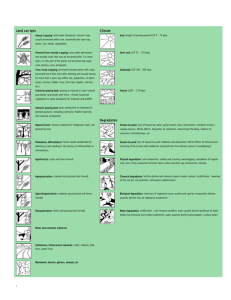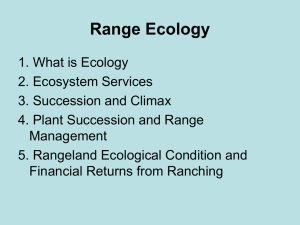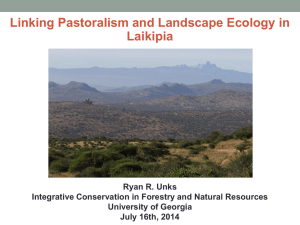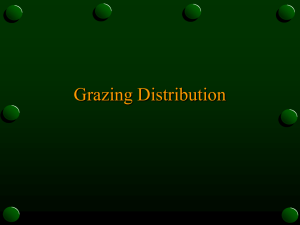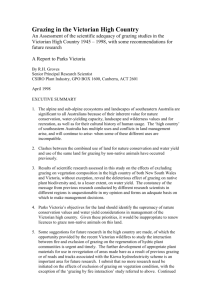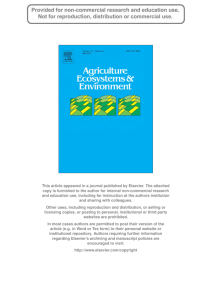Online Resource 4 Supplementary figures and tables Vegetation
advertisement
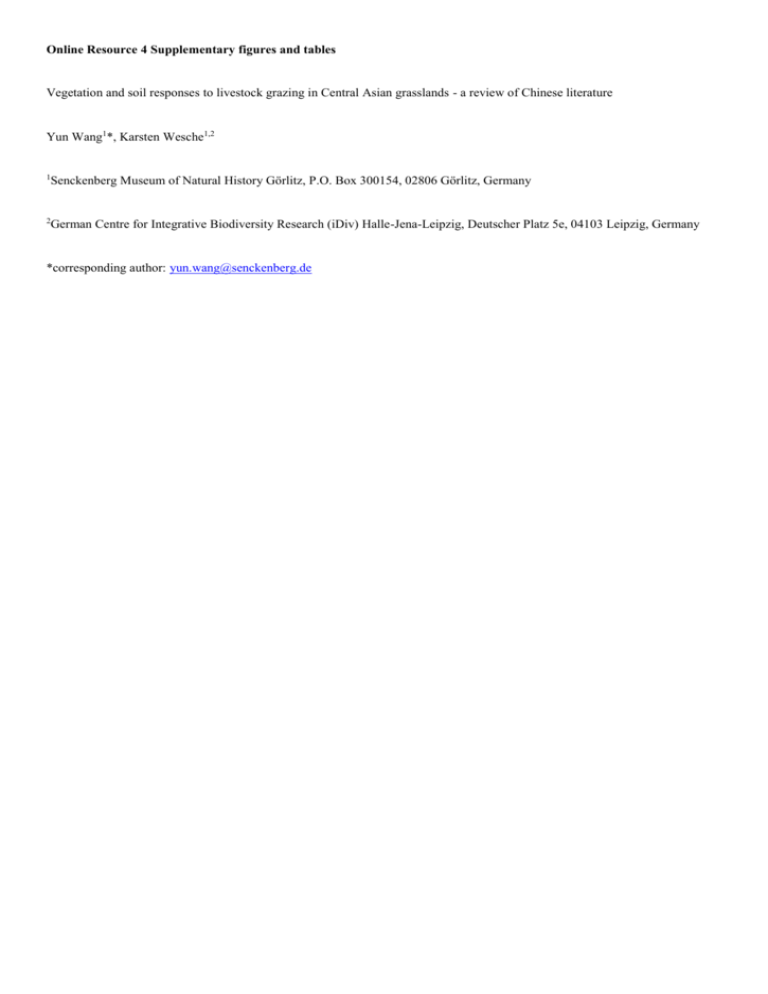
Online Resource 4 Supplementary figures and tables Vegetation and soil responses to livestock grazing in Central Asian grasslands - a review of Chinese literature Yun Wang1*, Karsten Wesche1,2 1 Senckenberg Museum of Natural History Görlitz, P.O. Box 300154, 02806 Görlitz, Germany 2 German Centre for Integrative Biodiversity Research (iDiv) Halle-Jena-Leipzig, Deutscher Platz 5e, 04103 Leipzig, Germany *corresponding author: yun.wang@senckenberg.de Fig. S1 Correlations between climate data extracted from the CMF-model and originally reported climate data from publications: a) mean annual temperature (T), b) mean annual precipitation (P). Pearson correlation coefficient and sample sizes are indicated in the figures a) b) Fig. S2 Main environmental conditions for different vegetation types (DS = desert steppe; S = steppe; ADS = alpine desert steppe; AS = alpine steppe; AM = alpine meadow; ASW = alpine swamp): a) precipitation (P) and its coefficient of variance (cvP), and b) elevation (Elev) and temperature (T) (mean ± sd) a) b) Fig. S3 Hypothetical shapes for six grazing response types (positive, negative, neutral, unimodal, reversed unimodal and Vegetation or soil variables fluctuating) of vegetation or soil variables along the grazing intensity gradient Grazing intensity (from non-light to heavy grazing) Positive Negative Neutral Unimodal ReversedUnimodal Fluctuating Fig. S4 Flowchart of study retrieval and selection: Extracting vegetation or soil indicators (a, yellow), combining them with explanatory climate variables (b, blue) and quantifying grazing intensity (c, grey). From 103 publications (Appendix 1): a) We separated independent experiments and combined datasets from same study sites (see more details in the method section), which yielded 131 datasets including vegetation or soil variables. All reviewed studies and their main topics are plotted in Fig. 1; b) We extracted 100 sites (see Appendix 2) with independent locations and retrieved climate data based on their coordinates and elevation from the CMF database, resulting in 88 independent climate datasets (with annual precipitation and its interannual variation and mean annual temperature; and c) Of the extracted 131 datasets, 30 studies reported specific information on the amount of livestock that were grazing at a fixed area within a given time period, of which only 20 reported the estimated primary productivity from the ungrazed plots and thus allowed for a reliable calculation of grazing pressure (shown in Fig. 3) 103 publications b) coordinates (Appendix 2) (Appendix1) a) 100 sites coordinates 88 climate datasets elevation 1) experiment separation 2) indicator combination 131 vegetation or soil datasets (Fig. 1) c) 30 quantified 1) livestock density 2) grazing period grazing intensity aboveground biomass from fenced plots 20 studies (Fig. 3) Table S1 Pearson correlations among calculated relative grazing responses for different indicators under the heaviest grazing regime (correlations stronger than r=|0.5| were highlighted) Richness_GE Cover_GE AGB_GE BGB_GE rsRatio_GE pH_GE BD_GE SOC_GE tN_GE tP_GE aP_GE Richness_GE Cover_GE 0.31 AGB_GE 0.31 0.39 BGB_GE -0.01 0.28 0.27 rsRatio_GE -0.21 0.04 -0.11 0.80 pH_GE 0.08 0.18 0.01 -0.10 -0.14 BD_GE 0.26 -0.40 -0.14 -0.53 -0.79 0.02 0 0.27 0.32 0.62 0.29 -0.20 -0.31 tN_GE -0.05 -0.05 0.28 0.70 0.30 0.07 -0.29 0.36 tP_GE -0.31 -0.21 0.17 0.46 -0.14 0.14 -0.06 0.20 0.64 aP_GE -0.21 -0.29 -0.08 0.63 0.03 -0.06 0.02 0.10 0.70 SOC_GE 0.71 Table S2 Pearson correlations among indicators (Abbreviations are the same as in Table 1) and environmental variables (Elev = elevation, T = mean annual temperature, cvP = interannual variation of precipitation) for heavy (upper diagonal) and light grazing conditions (lower diagonal). For details on grazing intensity see Method section in the main text. Correlations stronger than r=|0.5|, r² = 0.25 are highlighted Light/Heavy Elev T P cvP Elev Richness Cover AGB BGB rsRatio pH BD -0.07 0.15 0.09 0.11 -0.22 -0.27 -0.21 0.26 0.40 -0.30 SOC tN -0.03 -0.24 -0.05 0.14 0.23 0.25 0.15 0.09 0.18 0.40 0.18 -0.09 -0.22 -0.11 -0.20 0.39 0.32 0.05 -0.50 -0.54 0.40 0.63 0.61 0.09 -0.45 -0.43 -0.32 -0.04 0.45 0.28 -0.24 -0.50 -0.53 -0.20 0.36 0.20 0.18 -0.05 -0.21 0.04 0.11 0.11 0.26 -0.34 0.65 0.57 0.05 -0.38 -0.55 0.76 0.77 0.60 0.20 0.55 -0.06 -0.36 -0.54 0.60 0.58 0.51 0.18 0.68 -0.10 -0.44 0.40 0.38 0.23 0.05 -0.29 -0.23 0.12 0.06 0.09 0.05 0.00 0.13 -0.20 -0.46 -0.27 -0.68 -0.69 -0.10 -0.23 0.84 0.49 0.42 0.68 0.44 T -0.56 P 0.55 -0.37 cvP -0.27 0.18 -0.69 Richness -0.27 -0.23 0.09 -0.10 Cover 0.10 -0.25 0.54 -0.55 0.24 AGB -0.04 -0.17 0.38 -0.42 0.19 0.50 BGB 0.18 -0.13 0.27 -0.42 -0.14 0.24 0.29 rsRatio 0.20 -0.12 0.12 -0.23 -0.37 -0.11 -0.12 0.82 pH -0.31 0.36 -0.50 0.51 -0.22 -0.42 -0.39 -0.35 -0.45 BD -0.16 0.27 -0.73 0.46 -0.03 -0.76 -0.70 0.13 0.29 0.22 SOC 0.18 -0.14 0.41 -0.26 -0.06 0.68 0.39 0.46 0.24 0.18 -0.66 tN 0.20 -0.32 0.50 -0.44 -0.07 0.74 0.47 0.38 0.36 0.01 -0.71 0.85 tP 0.23 -0.16 0.47 -0.43 0.05 0.53 0.41 0.72 0.72 -0.22 -0.23 0.53 0.54 aP 0.16 -0.27 0.07 -0.20 -0.31 0.26 0.21 0.08 0.02 -0.19 -0.27 0.60 0.49 tP aP -0.14 -0.15 Fig S5 Relative change in aboveground biomass by heavy grazing along the precipitation gradient Fig S6 Relationships between absolute values of a) plant species richness, b) soil bulk density, c) aboveground biomass, d) belowground biomass, e) root / shoot ratio, f) soil total N, and the most important environmental factors (based on Table 4) under light (blue) and heavy (black) grazing conditions (corresponding to Fig. 4 for relative grazing effects) a) plant species richness d) belowground biomass b) soil bulk density e) root / shoot ratio c) aboveground biomass f) soil total N

